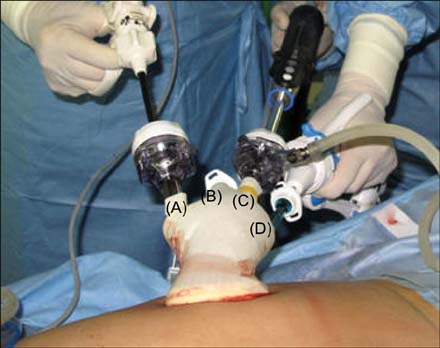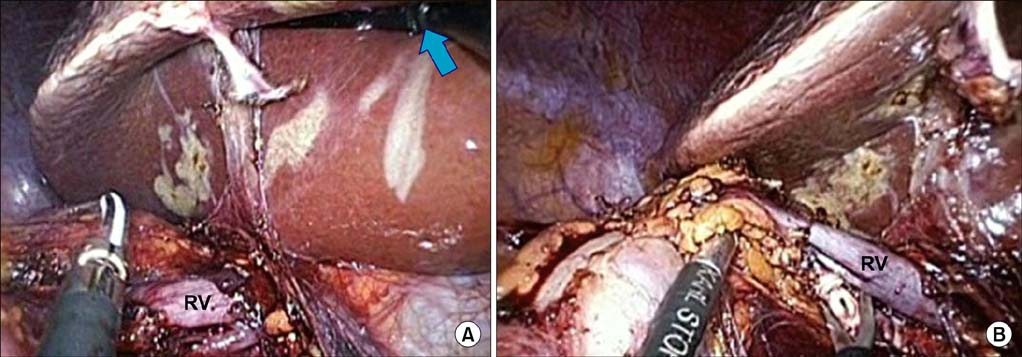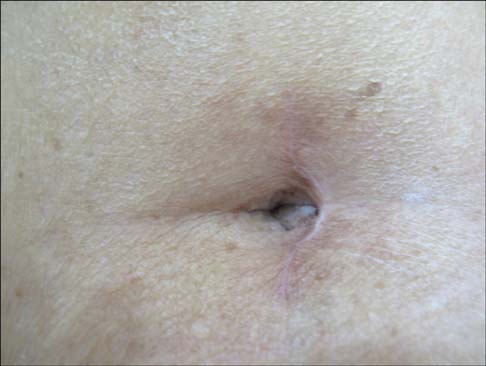Korean J Urol.
2010 Jul;51(7):472-476.
Early Experience of Laparoendoscopic Single-Site Nephroureterectomy for Upper Urinary Tract Tumors
- Affiliations
-
- 1Department of Urology, Wonkwang University School of Medicine, Iksan, Korea. seraph@wonkwang.ac.kr
Abstract
- PURPOSE
We evaluated the feasibility of a laparoendoscopic single-site (LESS) nephroureterectomy for an upper urinary tract tumor.
MATERIALS AND METHODS
Between March 2009 and September 2009, 4 patients with upper urinary tract tumors underwent LESS nephroureterectomy. The mean age of the 2 female and 2 male patients was 69 years old, and their mean body mass index was 23.0. We used a homemade single-port device made with a surgical glove and a wound retractor, which were put into a 4 cm periumbilical incision. Operations with articulating and rigid laparoscopic instruments were performed transperitoneally. An open technique with a 4 cm additional midline incision and laparoscopic technique with an endoscopic stapler were used for the treatment of the distal ureter and bladder cuff.
RESULTS
All cases were completed successfully, without conversion to conventional laparoscopy or open surgery. The mean operative time was 169.5 minutes. The mean estimated blood loss was 361.4 ml. One patient had transfusion and wound infection. The mean hospital stay was 7.8 days. The mean specimen weight and tumor size were 271.8 g and 2.9 cm. Pathologic results of all cases showed urothelial carcinoma with a negative surgical margin. Three patients were in stage T3N0M0 and 1 was in stage T2N0M0.
CONCLUSIONS
Our initial experience shows that LESS nephroureterectomy with a homemade single-port device is technically feasible. However, long term follow-up for the effect on cancer control and technical development for comfortable surgery are needed.
Keyword
MeSH Terms
Figure
Reference
-
1. Clayman RV, Kavoussi LR, Figenshau RS, Chandhoke PS, Albala DM. Laparoscopic nephroureterectomy: initial clinical case report. J Laparoendosc Surg. 1991. 1:343–349.2. McDougall EM, Clayman RV, Elashry O. Laparoscopic nephroureterectomy for upper tract transitional cell cancer: the Washington University experience. J Urol. 1995. 154:975–979.3. Janetschek G, Reissigl A, Peschel R, Bartsch G. Laparoscopic nephroureterectomy. Br J Urol. 1993. 72:987–988.4. Seo IY, Yu DW, Oh GJ, Rim JS. Early experience of retroperitoneoscopic nephroureterectomy for transitional cell carcinoma of renal pelvis and ureter. Korean J Urol. 2006. 47:1263–1268.5. Rassweiler JJ, Schulze M, Marrero R, Frede T, Palou Redorta J, Bassi P. Laparoscopic nephroureterectomy for upper urinary tract transitional cell carcinoma: is it better than open surgery? Eur Urol. 2004. 46:690–697.6. Hattori R, Yoshino Y, Gotoh M, Katoh M, Kamihira O, Ono Y. Laparoscopic nephroureterectomy for transitional cell carcinoma of renal pelvis and ureter: Nagoya experience. Urology. 2006. 67:701–705.7. Bariol SV, Stewart GD, McNeill SA, Tolley DA. Oncological control following laparoscopic nephroureterectomy: 7-year outcome. J Urol. 2004. 172:1805–1808.8. Gill IS, Canes D, Aron M, Haber GP, Goldfarb DA, Flechner S, et al. Single port transumbilical (E-NOTES) donor nephrectomy. J Urol. 2008. 180:637–641.9. Steinway ML, Lengu IJ, Cherullo EE, Ponsky LE. Laparoendoscopic single-site (LESS) nephrectomy through a Pfannenstiel incision: porcine model. J Endourol. 2009. 23:1293–1296.10. Tracy CR, Raman JD, Cadeddu JA, Rane A. Laparoendoscopic single-site surgery in urology: where have we been and where are we heading? Nat Clin Pract Urol. 2008. 5:561–568.11. Gettman MT, Box G, Averch T, Cadeddu JA, Cherullo E, Clayman RV, et al. Consensus statement on natural orifice transluminal endoscopic surgery and single-incision laparoscopic surgery: heralding a new era in urology? Eur Urol. 2008. 53:1117–1120.12. Raman JD, Bensalah K, Bagrodia A, Stern JM, Cadeddu JA. Laboratory and clinical development of single keyhole umbilical nephrectomy. Urology. 2007. 70:1039–1042.13. Raman JD, Bagrodia A, Cadeddu JA. Single-incision, umbilical laparoscopic versus conventional laparoscopic nephrectomy: a comparison of perioperative outcomes and short-term measures of convalescence. Eur Urol. 2009. 55:1198–1204.14. Raybourn JH 3rd, Rane A, Sundaram CP. Laparoendoscopic single-site surgery for nephrectomy as a feasible alternative to traditional laparoscopy. Urology. 2010. 75:100–103.15. Aron M, Canes D, Desai MM, Haber GP, Kaouk JH, Gill IS. Transumbilical single-port laparoscopic partial nephrectomy. BJU Int. 2009. 103:516–521.16. Agarwal DK, Khaira HS, Clarke D, Tong R. Modified transurethral technique for the management of distal ureter during laparoscopic assisted nephroureterectomy. Urology. 2008. 71:740–743.17. Srirangam SJ, van Cleynenbreugel B, van Poppel H. Laparoscopic nephroureterectomy: the distal ureteral dilemma. Adv Urol. 2009. 316807.18. Park YH, Kang MY, Jeong MS, Choi H, Kim HH. Laparoendoscopic single-site nephrectomy using a homemade single-port device for single-system ectopic ureter in a child: initial case report. J Endourol. 2009. 23:833–835.19. Jeong W, Jeon HG, Yu HS, Kim KH, Yang SC, Rha KH, et al. Embryonic-natural orifice transluminal endoscopic surgery nephrectomy. Korean J Urol. 2009. 50:609–612.
- Full Text Links
- Actions
-
Cited
- CITED
-
- Close
- Share
- Similar articles
-
- A Comparative Study of Laparoendoscopic Single-Site Surgery Versus Conventional Laparoscopy for Upper Urinary Tract Malignancies
- Initial Experience with Retroperitoneal Laparoendoscopic Single-Site Surgery for Upper Urinary Tract Surgery
- Urothelial Tumors of the Upper Urinary Tract: Multiplicity and Prognostic Variables
- Urothelial Tumors of the Upper Urinary Tract, 15 Cases
- Pathologic Features of Recurrent Bladder Tumors after Upper Urinary Tract Transitional Cell Carcinoma




